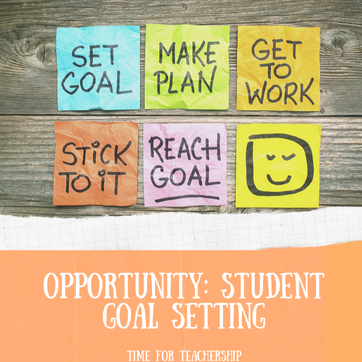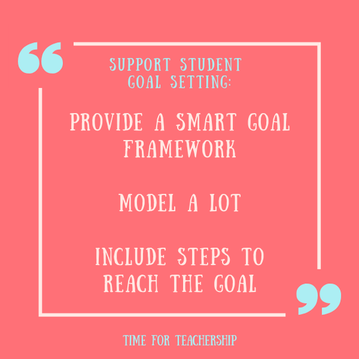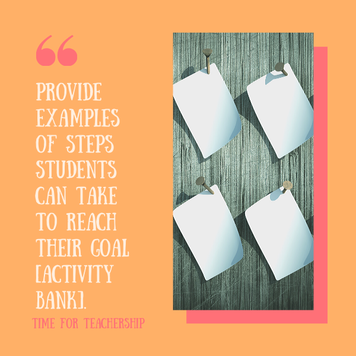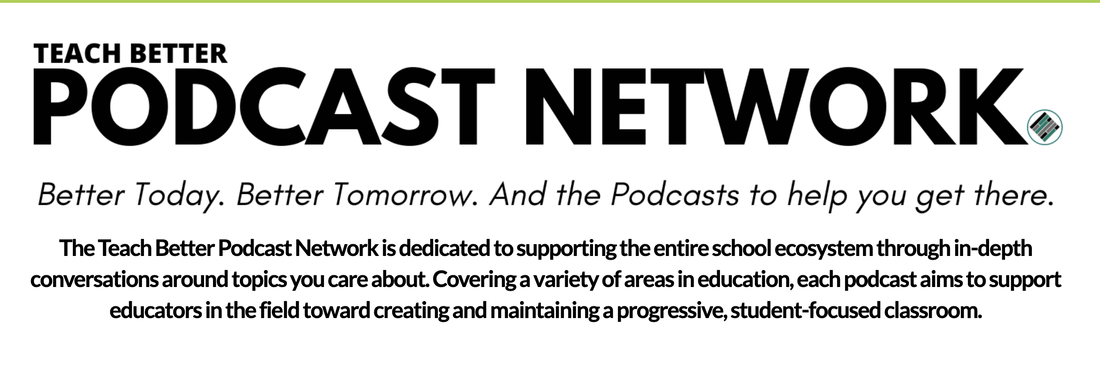|
As we continue to consider the opportunities we have to try out student-centered approaches to instruction while teaching virtually, I want to talk about student goal setting. Research tells us that when people set ambitious goals, they are more likely to achieve them than smaller goals, and they are more likely to prioritize “goal-relevant” activities over “nonrelevant” activities to seek new knowledge (Locke & Lathan, 2006). I would love for my students to achieve ambitious goals they set for themselves, and I certainly would love for students to be motivated by their goals to learn more! That’s a teacher’s dream. Research also tells us that writing goals down significantly increases the likelihood we’ll achieve them, and sending weekly progress reports for accountability makes it even more likely we’ll get to that finish line (Matthews, 2015, accessible on this page). These research findings feel particularly translatable to the classroom, as we could have students write their goals and submit a reflection on their progress towards the goal each week. Sounds great, right? The question is: How do I support students to set high quality goals? Goal setting can be incredibly effective, but most students—even most adults—are not prepared to write effective goals. There are a few things I’ve found helpful in supporting students to set quality goals: using a SMART goal framework, lots of modeling, and an intentional inclusion of steps to reach the goal. SMART Goal Framework SMART goals are: Specific, Measurable, Achievable, Relevant, and Time-bound. I’ve found relevancy to be the least problematic component. Students usually set goals related to what we’re doing in class. The concept of setting a deadline by which to meet the goal is usually fine with students, but the achievable aspect of the chosen time frame is more challenging. Goal specificity usually comes with practice, but this will take some modeling. In my experience, the most challenging element of SMART goal setting for students is setting measurable goals. This requires lots of modeling and often direct support early on. A peer review of goals can also be helpful. Before students finalize their goal, they can share it with a peer and ask: How would you know I met my goal? If the peer has no idea, the student knows it is not measurable. (Of course, you can do a peer review for any or all of the aspects of a SMART goal.) Lots of Modeling To support students, we can set our own life/teacher goals. I am thinking specifically of two amazing teachers I coached who shared personal exercise goals with their students (i.e., I will run x miles keeping a pace of x minutes per mile; I will walk for x number of steps this week) because they were examples of goals that were specific and measurable. You could also set class goals together (e.g., we will spend x minutes on mindful breathing this week). When you’re first getting started with student goal setting, it may be helpful to offer sentence starters or a SMART goal setting template to help students formulate high quality goals. I also find it helpful (if students are okay with this) to share a few student-written goals and review them as a class, offering suggestions to strengthen a particular aspect that’s unclear or highlighting how each aspect is present in a high-quality goal. Inclusion of Steps to Reach the Goal In my experience, the #1 reason student goal setting is ineffective is the lack of follow-up. Students may set a wonderful SMART goal but then have no idea what to do to reach the goal. This problem can be addressed by including the steps students will take to reach their goal as part of a goal setting template. If there is a designated space for this, students can spend some time really thinking about what they can do to achieve the goal they set. We can also model and provide examples of what steps students can take to move towards their goals. One way to support students in selecting relevant activities for this part of the template is to provide an activity bank for students. Then, students can circle, highlight, or select from that bank. Over time, this scaffold can be removed or transitioned to an anchor chart on the wall which students could reference if needed. I love the idea of co-creating an activity bank with students by asking them how they might reach their goals and adding to an anchor chart as they share. To help you jumpstart student goal setting in your classroom, you can use my goal setting template by clicking the button below. One final note on student goal setting. I’ve worked with many teachers of younger students who have had success with this activity (and with the above template). If you teach young kids, know they are definitely capable of quality goal setting; it will just require a bit more scaffolding.
0 Comments
Leave a Reply. |
Details
For transcripts of episodes (and the option to search for terms in transcripts), click here!
Time for Teachership is now a proud member of the...AuthorLindsay Lyons (she/her) is an educational justice coach who works with teachers and school leaders to inspire educational innovation for racial and gender justice, design curricula grounded in student voice, and build capacity for shared leadership. Lindsay taught in NYC public schools, holds a PhD in Leadership and Change, and is the founder of the educational blog and podcast, Time for Teachership. Archives
May 2024
Categories |





 RSS Feed
RSS Feed